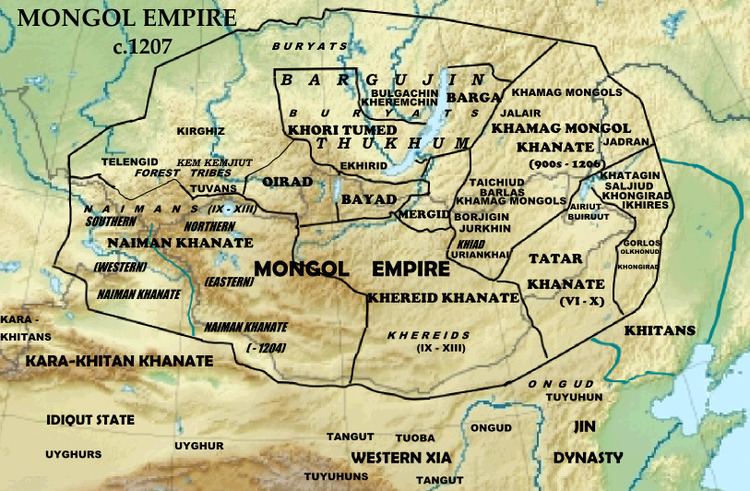Died 1218 | ||
 | ||
Kuchlug (also spelled Küchlüg, Küçlüg, Güčülüg) was a member of the Naiman tribe of western Mongolia who became the last ruler of Qara Khitai empire. The Naimans were defeated by Genghis Khan and he fled westward to the Qara Khitai, where he became an advisor. He later rebelled, usurped the throne and took control of Qara Khitai. He was killed in 1218 by the Mongols and the domain of the Qara Khitai absorbed into the rising Mongol Empire.
Contents
Naiman Origins and Westward Flight
Kuchlug was the son of Taibuqa, the Tayang Khan (leader) of the Naimans, a Mongol-speaking tribe. In 1204, Jamuqa, the chief Mongol rival of Temüjin (later known as Genghis Khan), fled to the Naimans. Temüjin followed and launched an assault upon the tribe. Taibuqa at first hesitated, considering it better to fall back to the Altai Mountains and attack the Mongols from there. Kuchlug, however, favored a direct assault on the Mongols on open ground. He went so far as to dismiss his father's plan as cowardly. Taibuqa relented and allowed Kuchlug to carry out his attack.
The battle was a disaster for the Naiman. Jamuqa abandoned them and fled. Taibuqa was mortally injured, and his main commander was killed. The rest of the tribe surrendered to Temüjin and were absorbed into his ranks. Kuchlug managed to escape and with a few Naiman soldiers fled westward towards the Kara Irtish.
Afterwards Genghis Khan was wary of the threat Kuchlug still posed. In 1208, they again met in battle, and Kuchlug was pushed further west into Semirechye. Reeling from a second defeat at the hands of the Mongols, Kuchlug turned to the Qara Khitai in Balasaghun for protection.
Qara Khitai Empire
Kuchlug was welcomed by Zhilugu, the Gur-khan (meaning Universal Khan), ruler of the Qara Khitai. Once he was accepted into the empire, Kuchlug quickly gained a strong foothold. He found service as an advisor for Gur-khan, and was allowed to marry one of the Gur-khan's daughters, Qûngû. He was later given the title of Khan, and was allowed to reorganize his fellow Naimans into a military unit under his command.
Usurpation of the throne
Around that time, the Qara Khitai were dealing with rebellions in the east, as well as engaging in a struggle against Muhammad II of the Khwarezmian Empire in the west. The Khwarezm-Shah took Bukhara in 1207, but was defeated by the Qara Khitai at Samarkand. Kuchlug, however, apparently had formed an alliance with the Khwarezm-Shah. In 1210, while the Gur-khan was dealing with a revolt by the Karakhanids at Samarkand, Kuchlug took the chance to rebel against his father-in-law, seizing the Qara Khitai's treasury at Uzgen. The Gur-khan left Samarkand to deal with Kuchlug, but the Khwarezm-Shah Muhammad used the opportunity to seize Samarkand, then defeated the Qara Khitai near Talas and gained control of Transoxiana.
The Gur-khan pulled back to his capital of Balasagun, and defeated Kuchlug who retreated eastward to his Naiman realm. However, in 1211, while the Gur-khan was out hunting, he was ambushed and captured by Kuchlug. The Khwarezm-Shah then joined Kuchlug in capturing the Qara Khitai Empire. The Gur-khan was allowed to remain ruler of the Qara Khitai, at least in name, but Kuchlug retained the real power. When the Gur-khan died in 1213, Kuchlug took direct control of the empire. While Kuchlug likely only intended to usurp the throne of the Qara Khitai, many historians considered the death of the Gur-khan the end of the Qara Khitai Empire.
Conflicts with Muhammad II
Once Kuchlug had established himself as ruler, Muhammad demanded the Qara Khitai Gur-khan to be handed over and a princess as a reward for his previous support. Kuchlug tried to stall, but eventually Muhammad became more aggressive. However, when Kuchlug threatened to resolve the rivalry by direct combat, Muhammad chose to evacuate the region of upper Jaxartes (Syr-Darya), demolished the settlements there in an attempt to form a buffer zone between his empire and Kuchlug's, and the Syr-Darya eventually came to be the de facto border between the two rulers.
Religious policy
Kuchlug was from the Naiman tribe, which were Nestorians. His wife, daughter of the Gur-khan, was a Buddhist, and convinced him to adopt Buddhism. However, in contrast to the policy of religious tolerance of the previous Qara Khitai ruler Gur-khans, once Kuchlug assumed power, he was reported to have instituted anti-Muslim policies. According to Persian historian Ata-Malik Juvayni, he would demand that a town’s Muslim population make a choice between either converting to Nestorianism or Buddhism, or donning Khitan garment, of which the population would choose to wear Khitan clothing. He was also reported to have crucified the imam of Hotan onto the door of his madrassa. His anti-Muslim policies and struggle against Muhammad may have served to inspire the legend of another incarnation of the Christian king of the Far East Prester John.
Downfall and death
Kuchlug attacked the city of Almaliq, and the Karlugs there appealed to Genghis Khan for help. In 1216, Genghis Khan dispatched his general Jebe to pursue Kuchlug. The Mongol first went to Almaliq, then proceeded on to the capital city of Balasaghun near which they defeated a Qara Khitai force of 30,000 men. Kuchlug fled southwards to Kashgar, however, his previous acts of pillaging and burning harvests in Kashgar when he first captured the town, his anti-Muslim policies, as well as the billeting of his troops on local households, had antagonized the people of Kashgar. When the Mongols approached Kashgar, Kuchlug, unable to find support in Kashgar, fled again. According to Ata-Malik Juvayni, the people of Kashgar, then killed his soldiers. He continued south across the Pamirs, eventually reaching the border between Badakhshan and Wakhan in 1218. There, a group of hunters caught him and handed him over to the Mongols. Kuchlug was beheaded, and according to the Chinese historical work Yuan Shi, his head was displayed across his former realm.
